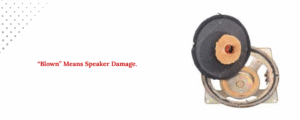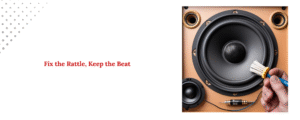Listening to music on a broken speaker is frustrating. If your favorite song sounds crackly or one side stops working completely, it ruins the experience and could end up costing you a lot. The good news is that not all broken speakers are lost forever. It’s possible to fix the issue yourself sometimes, or at least decide if it’s worth it to fix it or not. Let’s break it down in this article so you can choose whether to fix it yourself or buy a new one.
What Does “Blown” Mean for a Speaker?
A speaker that is “blown” usually means that it isn’t making sound right anymore. Possibly this means:
- No sound at all
- Sound that is distorted or fuzzy
- Sounds like rattling, buzzing, or popping
- Sounds only at certain levels or in certain bands
Loud volume, power surges, aging components, or manufacturing defects can all cause a speaker to blow. Most of the time, one of three parts is broken: the cone, the voice coil, or the suspension system.
Signs Your Speaker Might Be Blown
Before you get your wallet or tools out, do these things to make sure the problem is real:
Check Out Other Parts
First, check to see if the issue is with your speaker, the wires, or the sound source. You could try testing the speaker on a different device or switching the speaker cords.
Look at the Speaker
Take off the grille or cover and check the cone and surround for tears or damage that you can see.
Pay Close Attention
Play a track with a wide frequency range that is not very loud and pay close attention. The cause is probably the speaker who sounds off or doesn’t make any noise.
Use a Multimeter
Set the multimeter to the ohms setting and touch the leads to the speaker terminals. This is usually caused by a blown voice coil.
How to Fix Speakers Yourself: What You Can Do
You might be able to fix the speaker yourself if you’re handy and the damage isn’t too bad. Problems that often happen and how to fix them are listed below:
- Fix a Torn Cone or Surround: Use a light glue like rubber cement or a paper patch with fabric glue. There are also fix kits made just for audio.
- Fix a Voice Coil Wire That Has Come Loose: If the voice coil wire has come loose from the end, it can be snapped back together.
- Fixes for Damaged Dust Caps: Replace the dust cap or re-glue it with the right kind of glue to keep dust out of the coil.
- 4. Rattling from Loose Parts Fix: Tighten any internal screws or secure loose speaker components.
When to Replace the Speaker
While repairs can save money, they’re not always worth the effort. Here are signs that replacement is the better option:
- Widespread Damage: If the cone is torn, the coil is burned, or the magnet is broken.
- Poor Sound Quality After Repair: If the speaker still sounds bad after being fixed, the damage inside may be too great.
- Old or Cheap Speakers: If the speaker is from a cheap system or is many years old, it might be cheaper to get a new one.
- Matched Sets: If one speaker in a matched pair or set breaks, you should replace both to get the same stereo sound.
Tip: Replacement doesn’t always mean buying brand new—look for replacement parts or refurbished speakers from reputable sellers.
Tips to Prevent Future Speaker Damage
- Avoid Overdriving: Don’t max out sound settings. This is often a sign that something is wrong.
- Use the Right Amp: Make sure that the amount of power your amplifier puts out matches the size of your speakers.
- Keep Them Clean and Dry: To keep them safe from dust and water.
- Let Them Warm Up: A short warm-up at low volumes can keep speakers from getting too stressed, especially high-end ones.
Last Word: Do It Yourself or Replace?
If the damage isn’t too bad, you can fix your speaker yourself for a low cost. It’s also a rewarding project for music fans. It might be easier to replace a speaker if it is old and not worth fixing, but it might take more time, effort, and stress.
Always measure the value of your speaker versus the cost and trouble of the fix. With a careful method, you can either restore your old sound system or change to something even better.




